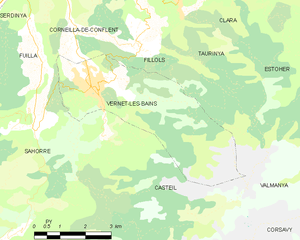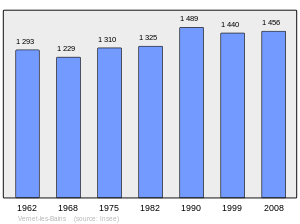Vernet-les-Bains
| Vernet-les-Bains | ||
|---|---|---|
|
The church and surrounding buildings in Vernet-les-Bains | ||
| ||
 Vernet-les-Bains | ||
|
Location within Occitanie region  Vernet-les-Bains | ||
| Coordinates: 42°33′00″N 2°23′19″E / 42.55°N 2.3886°ECoordinates: 42°33′00″N 2°23′19″E / 42.55°N 2.3886°E | ||
| Country | France | |
| Region | Occitanie | |
| Department | Pyrénées-Orientales | |
| Arrondissement | Prades | |
| Canton | Prades | |
| Intercommunality | Canigou–Val Cady | |
| Government | ||
| • Mayor (2001–2008) | Christian Payrou | |
| Area1 | 16.76 km2 (6.47 sq mi) | |
| Population (2006)2 | 1,570 | |
| • Density | 94/km2 (240/sq mi) | |
| Time zone | CET (UTC+1) | |
| • Summer (DST) | CEST (UTC+2) | |
| INSEE/Postal code | 66222 / 66820 | |
| Elevation |
559–2,760 m (1,834–9,055 ft) (avg. 850 m or 2,790 ft) | |
|
1 French Land Register data, which excludes lakes, ponds, glaciers > 1 km² (0.386 sq mi or 247 acres) and river estuaries. 2 Population without double counting: residents of multiple communes (e.g., students and military personnel) only counted once. | ||
Vernet-les-Bains (Catalan: Vernet) is a commune in the Pyrénées-Orientales department in southern France.
It is a centre for visitors and holidaymakers. The village enjoys a sunny climate (with, on average, 300 days of sunshine each year) and is set in a sheltered valley in the foothills of the Canigou mountain - which rises to a height of 2,785 metres (over 9,000 feet). Tranquil and restful, Vernet-les-Bains has long been known for its hot water spring. There is a professional spa/therapy centre in the village.
Geography
Localisation
Vernet-les-Bains is located in the canton of Prades and in the arrondissement of Prades.

Transport
Close by is the Yellow train which runs 63 kilometres (39 mi) from Villefranche-de-Conflent up to Mont-Louis and Latour-de-Carol. The line has the highest station in France at 1,593 metres (5,226 ft) and is both a vital lifeline during winter conditions and a favourite tourist attraction.
Villefranche-de-Conflent is also on a regional train line that connects to Perpignan.
Population

Sites of interest
The Entente Cordiale Monument in Vernet-les-Bains

Near the highest point in Vernet-les-Bains, next to the mairie (town hall), stands a monument to the Entente Cordiale of 1904. It is the only one of its kind in France.
The pedestal of the monument is made of Canigou granite. On it rest two white marble statues representing France and Britain. The pedestal itself is set upon a circular base. That in turn is located on a raised, level area of ground which covers 1,000 square metres and which is bounded by low stone walls.
The idea of erecting this monument was conceived around 1912 by the town council and its then mayor, Monsieur Joseph Mercader. The wealthy British visitors who regularly came to this health spa at that time actively supported the project. A committee of prominent French and British patrons was set up to promote the scheme. Its leading members were Lord Roberts and General Joffre. Monsieur Lambert-Violet, a leading Perpignan businessman, gave the land for the memorial to Vernet. The monument itself was the work of the Roussillon sculptor Gustave Violet, who displayed a model of his proposed work in 1913. However, progress came to a halt in 1914 with the outbreak of World War One. Little further happened until August 1920, when it was proclaimed by presidential decree that work on the monument would proceed but that it would be dedicated both to the Entente Cordiale and to the memory of those killed during the war. At the same time a new appeal was launched for funds to complete the project.
Work on erecting the monument soon got underway. Granite was hauled up from the bed of the River St-Vincent in carts pulled by oxen. The stonemason, Monsieur Herbetta, worked up to fourteen hours a day, often in the sun's full glare, fashioning and putting into place the enormously heavy blocks of stone. A circle of wrought-iron fencing was erected around the base of the monument. Monsieur Antoine Mercader remembers, as a six-year-old child, how he and other children watched with amazement as the craftsman, Monsieur Serra, poured molten lead into small holes in the ground to seal in place the fence's iron bars. When the monument was completed, it bore the following dedications:
"To the Entente Cordiale between France and Britain. To the glory of the Allied Nations. To the memory of soldiers from Vernet who died for their country"
Walks near Vernet-les-Bains
There are many beautiful walks from and close to Vernet-les-Bains. In particular it is an ideal base from which to climb to the summit of Canigou.
Notable people
Rudyard Kipling in Vernet-les-Bains
Rudyard Kipling, who was awarded the Nobel Prize for literature in 1907, stayed in Vernet-les-Bains in 1910, 1911 and 1914. At that time, Kipling was well known in France, following the success of the French version of his classic work, The Jungle Book.
While he was in Vernet, Kipling wrote about Canigou. In a letter to the Club Alpin, he praised it as "a magician among mountains".
Kipling also wrote a light-hearted short story entitled Why Snow Falls at Vernet. It makes fun of the English habit of always talking about the weather. This story (in its original English version, and in a French translation) can be seen on this link:
Today, the central bridge over the River Cady in Vernet-les-Bains is named after Kipling. The bridge, and the town itself, is featured prominently in the Danish thriller film ID:A (2011).
A short walk around the part of Vernet that was best known to Kipling can be seen on this link:
See also
References
External links
| Wikimedia Commons has media related to Vernet-les-Bains. |
- Website of the Vernet les Bains tourist office
- Website of the Vernet les Bains mairie
- Information in English about Vernet-les-Bains, including information about Rudyard Kipling's visits to Vernet.
- "Walks from and near Vernet-les-Bains"
.svg.png)